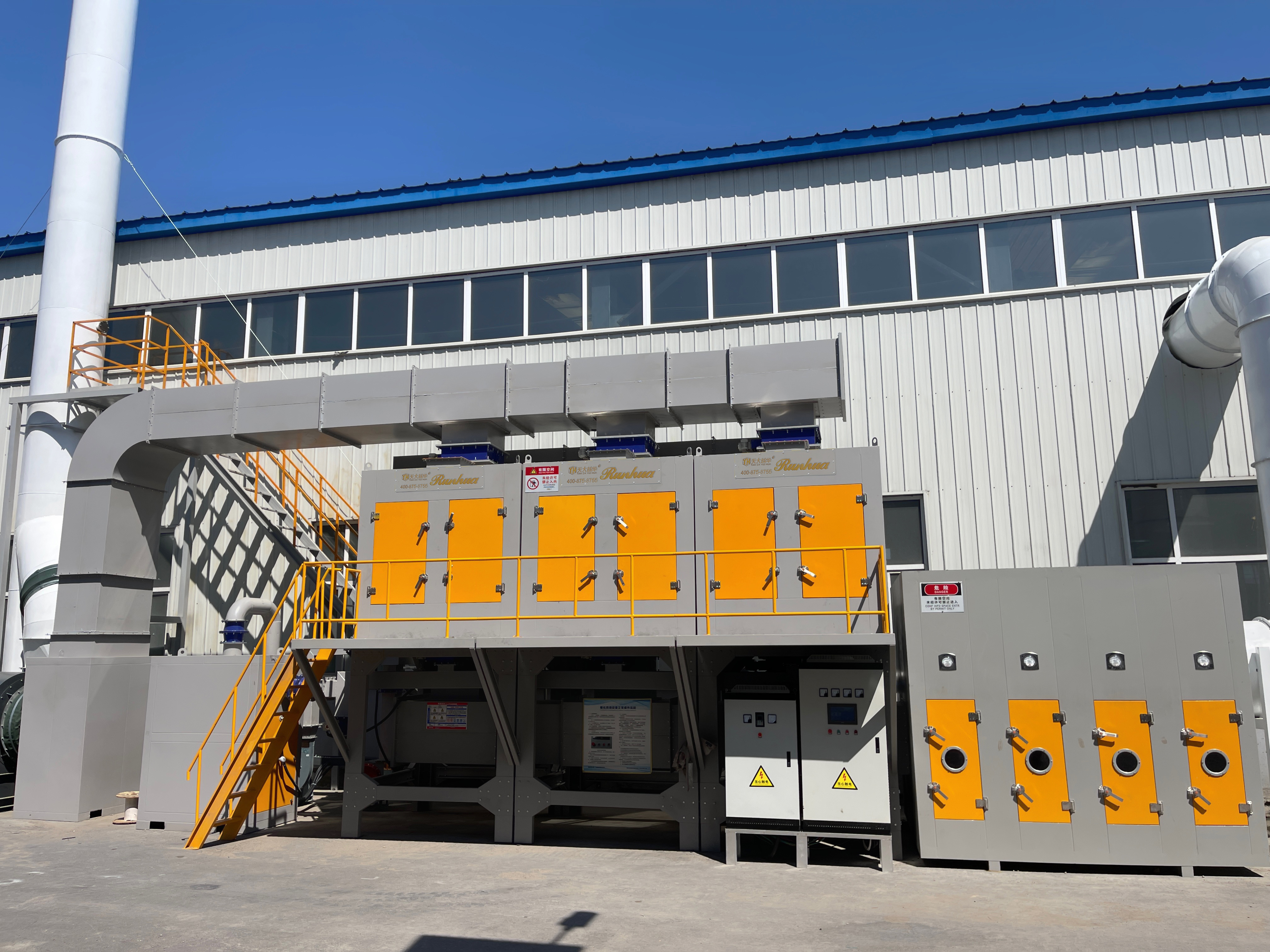 地圖 - 熱線
地圖 - 熱線
 地圖 - 熱線
地圖 - 熱線
熱門搜索: 中央除塵設(shè)備 旱煙除塵器 廢水處理設(shè)備 催化燃燒設(shè)備 RTO設(shè)備 危廢暫存間
客戶服務(wù)熱線:15392885678
行業(yè)動(dòng)態(tài)
- 服務(wù)熱線 - 15392885678 15069779222
雖然VOCs治理工藝大家可能耳熟能詳,今天我們溫故知新來根據(jù)適用場(chǎng)景,系統(tǒng)簡(jiǎn)要說一說VOCs治理幾大常用的工藝。
Although VOCs treatment processes may be familiar to everyone, today we will review the old and learn the new, and based on the applicable scenarios, systematically briefly introduce several commonly used VOCs treatment processes.
【干貨4點(diǎn)】
【 4 points of dry goods 】
吸附法
Adsorption method
吸附法是一種廣泛應(yīng)用于有機(jī)廢氣處理的技術(shù),特別適合處理低濃度、高流量的有機(jī)廢氣。這種方法具有諸多優(yōu)點(diǎn),如能耗低、凈化效率高、能徹底清除有害有機(jī)廢氣等。在許多工業(yè)生產(chǎn)過程中,有機(jī)廢氣的排放量較大,對(duì)環(huán)境和人體健康構(gòu)成嚴(yán)重威脅。吸附法通過利用吸附劑(如活性炭、活性碳纖維等)的多孔結(jié)構(gòu)和表面吸附力,將廢氣中的VOCs分子吸附在固體表面,從而實(shí)現(xiàn)凈化目的。
Adsorption method is a widely used technology for organic waste gas treatment, especially suitable for treating low concentration and high flow organic waste gas. This method has many advantages, such as low energy consumption, high purification efficiency, and the ability to thoroughly remove harmful organic waste gases. In many industrial production processes, the emission of organic waste gas is significant, posing a serious threat to the environment and human health. The adsorption method utilizes the porous structure and surface adsorption force of adsorbents (such as activated carbon, activated carbon fiber, etc.) to adsorb VOCs molecules in exhaust gas onto solid surfaces, thereby achieving purification purposes.
吸附法的優(yōu)勢(shì):
Advantages of adsorption method:
1. 能耗低:吸附法處理有機(jī)廢氣時(shí),能量消耗較少。這主要是因?yàn)槲竭^程主要依靠物理吸附,通過吸附劑與有機(jī)分子之間的范德華力實(shí)現(xiàn)分離,無需額外的化學(xué)反應(yīng)或高溫條件,從而顯著降低了能源消耗。
1. Low energy consumption: Adsorption method consumes less energy when treating organic waste gas. This is mainly because the adsorption process relies on physical adsorption, which achieves separation through van der Waals forces between the adsorbent and organic molecules, without the need for additional chemical reactions or high temperature conditions, thereby significantly reducing energy consumption.
2. 效率高:吸附法的處理效率通常很高。活性炭等吸附劑具有豐富的孔隙結(jié)構(gòu)和較大的比表面積,能夠迅速而有效地吸附有機(jī)分子。同時(shí),通過調(diào)節(jié)和控制吸附條件(如溫度、壓力和接觸時(shí)間),可以進(jìn)一步提高處理效率。
2. High efficiency: The treatment efficiency of adsorption method is usually very high. Activated carbon and other adsorbents have rich pore structures and large specific surface areas, which can quickly and effectively adsorb organic molecules. Meanwhile, by adjusting and controlling the adsorption conditions (such as temperature, pressure, and contact time), the processing efficiency can be further improved.
注意事項(xiàng):
Notes:
1.吸附劑的選擇至關(guān)重要,影響處理效果:在實(shí)際應(yīng)用中,需要根據(jù)廢氣的成分、濃度和流量等因素選擇合適的吸附劑。不同的吸附劑對(duì)不同的有機(jī)分子具有不同的吸附性能,因此選擇合適的吸附劑是確保處理效果的關(guān)鍵。
1. The selection of adsorbent is crucial and affects the treatment effect: In practical applications, it is necessary to choose the appropriate adsorbent based on factors such as the composition, concentration, and flow rate of the exhaust gas. Different adsorbents have different adsorption properties for different organic molecules, so choosing the appropriate adsorbent is the key to ensuring treatment effectiveness.
2.設(shè)備體積較大,工藝流程相對(duì)復(fù)雜:相比于其他廢氣處理方法,吸附法的設(shè)備體積通常較大,工藝流程也相對(duì)復(fù)雜。這主要是因?yàn)槲竭^程需要一定的時(shí)間和空間來實(shí)現(xiàn)有機(jī)分子與吸附劑之間的充分接觸和分離。因此,在設(shè)計(jì)和運(yùn)行過程中需要充分考慮設(shè)備的規(guī)模和自動(dòng)化程度。
2. The equipment volume is relatively large and the process flow is relatively complex: Compared with other waste gas treatment methods, the adsorption method usually has a larger equipment volume and a relatively complex process flow. This is mainly because the adsorption process requires a certain amount of time and space to achieve sufficient contact and separation between organic molecules and adsorbents. Therefore, in the design and operation process, it is necessary to fully consider the scale and degree of automation of the equipment.
3.廢氣中如有大量雜質(zhì),需注意人員防護(hù):如果廢氣中含有大量的雜質(zhì)或其他有害物質(zhì),可能會(huì)對(duì)吸附劑和設(shè)備造成損害或影響人員的健康。在這種情況下,需要采取相應(yīng)的措施進(jìn)行人員防護(hù)和設(shè)備保護(hù),確保操作安全和環(huán)境安全。
3. If there are a large amount of impurities in the exhaust gas, attention should be paid to personnel protection: If the exhaust gas contains a large amount of impurities or other harmful substances, it may cause damage to adsorbents and equipment or affect the health of personnel. In this situation, corresponding measures need to be taken for personnel protection and equipment protection to ensure operational safety and environmental safety.
熱破壞法
Thermal destruction method
熱破壞法是一種高效處理?yè)]發(fā)性有機(jī)化合物(VOCs)廢氣的方法。其原理是在高溫下,通過直接燃燒或催化燃燒,使化工廠廢氣中的有機(jī)物質(zhì)發(fā)生化學(xué)反應(yīng),轉(zhuǎn)化為無害的二氧化碳和水。這種方法特別適合處理高濃度的化工廠廢氣,能有效去除有機(jī)污染物。
Thermal decomposition is an efficient method for treating volatile organic compounds (VOCs) waste gas. The principle is that at high temperatures, organic substances in the exhaust gas of chemical plants undergo chemical reactions through direct combustion or catalytic combustion, and are converted into harmless carbon dioxide and water. This method is particularly suitable for treating high concentration chemical plant exhaust gas and can effectively remove organic pollutants.
熱破壞法的具體實(shí)施方式:
The specific implementation method of thermal destruction method:
直接燃燒技術(shù)通過將化工廠廢氣與適量空氣充分混合,形成可燃混合物,然后在高溫(通常超過800℃)下進(jìn)行燃燒。在這個(gè)過程中,VOCs與氧氣結(jié)合,發(fā)生氧化反應(yīng),生成二氧化碳和水蒸氣,以及其他少量無機(jī)化合物。由于反應(yīng)溫度較高,通常需要使用特殊設(shè)計(jì)的燃燒器和高效換熱系統(tǒng)來控制和處理化工廠廢氣。
Direct combustion technology involves thoroughly mixing the exhaust gas from a chemical plant with an appropriate amount of air to form a combustible mixture, which is then burned at high temperatures (usually exceeding 800 ℃). In this process, VOCs combine with oxygen, undergo oxidation reactions, generate carbon dioxide and water vapor, as well as other small amounts of inorganic compounds. Due to the high reaction temperature, it is usually necessary to use specially designed burners and efficient heat exchange systems to control and treat chemical plant exhaust gases.
催化燃燒技術(shù)則是利用催化劑的作用,在較低的溫度(通常在200-400℃之間)下促進(jìn)化工廠廢氣中的有機(jī)物發(fā)生氧化分解。催化劑通常采用貴金屬如鉑(Pt)、鈀(Pd)等或者氧化物類物質(zhì),它們能夠降低反應(yīng)活化能,提高反應(yīng)速率,使得VOCs在接近常溫條件下就能完全氧化為二氧化碳和水,同時(shí)釋放出大量的熱量。
Catalytic combustion technology utilizes the action of catalysts to promote the oxidation and decomposition of organic compounds in chemical plant exhaust gases at lower temperatures (usually between 200-400 ℃). Catalysts usually use precious metals such as platinum (Pt), palladium (Pd), or oxide materials, which can reduce the activation energy of the reaction, increase the reaction rate, and enable VOCs to be completely oxidized to carbon dioxide and water at near room temperature, while releasing a large amount of heat.
熱破壞法處理化工廠廢氣的優(yōu)勢(shì):
The advantages of using thermal destruction method to treat chemical plant waste gas:
處理效率極高,通常可達(dá)98%以上,這意味著大部分有機(jī)污染物都能得到有效轉(zhuǎn)化和去除。
The processing efficiency is extremely high, usually reaching over 98%, which means that most organic pollutants can be effectively converted and removed.
可回收利用廢氣中的熱能,降低能耗。在燃燒或催化燃燒過程中產(chǎn)生的大量熱量可以用于預(yù)熱助燃空氣或其他工藝流程中,實(shí)現(xiàn)能源的再利用,符合循環(huán)經(jīng)濟(jì)和綠色環(huán)保的理念。
The heat energy in the exhaust gas can be recycled to reduce energy consumption. The large amount of heat generated during combustion or catalytic combustion can be used to preheat combustion air or in other process flows, achieving energy reuse that conforms to the concepts of circular economy and green environmental protection.
實(shí)施熱破壞法處理化工廠廢氣時(shí)需要注意的事項(xiàng):
Precautions to be taken when implementing thermal destruction method to treat chemical plant waste gas:
由于高溫處理過程中對(duì)設(shè)備材料的耐高溫性能要求較高,必須確保所有涉及高溫操作的設(shè)備和部件如燃燒室、換熱器、管道等具有足夠的耐熱性和穩(wěn)定性,以防止因高溫導(dǎo)致設(shè)備損壞或安全事故。對(duì)于催化燃燒法,由于催化劑在使用過程中會(huì)逐漸失去活性或者受到污染物的毒化而失效,需要定期進(jìn)行更換,以保證催化燃燒反應(yīng)的持續(xù)高效進(jìn)行。
Due to the high temperature resistance requirements for equipment materials during high-temperature processing, it is necessary to ensure that all equipment and components involved in high-temperature operations, such as combustion chambers, heat exchangers, pipelines, etc., have sufficient heat resistance and stability to prevent equipment damage or safety accidents caused by high temperatures. For catalytic combustion method, due to the gradual loss of activity or poisoning by pollutants during use, the catalyst needs to be replaced regularly to ensure the continuous and efficient progress of catalytic combustion reaction.
生物處理法
Biological treatment method
生物處理法是一種環(huán)保的廢氣處理技術(shù),利用微生物的代謝作用將廢氣中的揮發(fā)性有機(jī)化合物(VOCs)轉(zhuǎn)化為無害的物質(zhì),如水和二氧化碳。這種處理方法具有諸多優(yōu)點(diǎn),包括投資成本較低、運(yùn)行費(fèi)用低廉、操作簡(jiǎn)便以及應(yīng)用范圍廣泛等,因此被廣泛認(rèn)為是最具發(fā)展前景的化工廠廢氣處理技術(shù)之一。
Biological treatment is an environmentally friendly waste gas treatment technology that utilizes the metabolic process of microorganisms to convert volatile organic compounds (VOCs) in waste gas into harmless substances such as water and carbon dioxide. This treatment method has many advantages, including low investment costs, low operating expenses, easy operation, and wide application range. Therefore, it is widely regarded as one of the most promising chemical plant waste gas treatment technologies.
生物處理法的類型:
Types of biological treatment methods:
生物洗滌法:這種方法利用微生物、營(yíng)養(yǎng)物和水組成的微生物吸收液來處理廢氣。廢氣通過與微生物吸收液接觸,其中的VOCs被吸收并轉(zhuǎn)化為無害物質(zhì)。
Biological washing method: This method uses a microbial absorption solution composed of microorganisms, nutrients, and water to treat exhaust gas. Waste gas comes into contact with microbial absorption solution, where VOCs are absorbed and converted into harmless substances.
生物過濾法:廢氣通過接種有微生物的生物濾料層,VOCs被微生物降解。這種方法具有處理效率高、設(shè)備簡(jiǎn)單等優(yōu)點(diǎn),但需要定期更換濾料。
Biological filtration method: The exhaust gas passes through a biological filter layer inoculated with microorganisms, and VOCs are degraded by microorganisms. This method has the advantages of high processing efficiency and simple equipment, but it requires regular replacement of filter media.
生物滴濾法:結(jié)合了生物過濾和噴淋的優(yōu)點(diǎn),廢氣在塔內(nèi)與生物濾料接觸并降解。這種方法可以有效地去除多種VOCs,同時(shí)還可以去除顆粒物和臭味。
Biological drip filtration method: Combining the advantages of biological filtration and spraying, the exhaust gas comes into contact with the biological filter material in the tower and degrades. This method can effectively remove various VOCs, as well as particulate matter and odors.
優(yōu)勢(shì):
Advantage:
投資和運(yùn)行費(fèi)用低:生物處理法的設(shè)備簡(jiǎn)單,運(yùn)行維護(hù)成本較低,適合各類企業(yè)和工廠使用。
Low investment and operating costs: The biological treatment method has simple equipment and low operation and maintenance costs, making it suitable for various enterprises and factories to use.
無二次污染:生物處理法不會(huì)產(chǎn)生二次污染,處理后的廢氣完全轉(zhuǎn)化為無害物質(zhì)。
No secondary pollution: The biological treatment method does not produce secondary pollution, and the treated exhaust gas is completely converted into harmless substances.
處理效率高:生物處理法具有較高的處理效率,可以快速有效地去除廢氣中的VOCs。
High processing efficiency: Biological treatment method has high processing efficiency and can quickly and effectively remove VOCs from exhaust gas.
注意事項(xiàng) :
matters needing attention:
微生物對(duì)生長(zhǎng)環(huán)境要求較高,需保持適宜的溫濕度:生物處理法的核心是微生物,而微生物的生長(zhǎng)和代謝受到環(huán)境因素的影響。因此,需要嚴(yán)格控制設(shè)備的溫濕度,以保證微生物的正常生長(zhǎng)和代謝。
Microorganisms have high requirements for their growth environment and need to maintain appropriate temperature and humidity: the core of biological treatment methods is microorganisms, and the growth and metabolism of microorganisms are influenced by environmental factors. Therefore, it is necessary to strictly control the temperature and humidity of the equipment to ensure the normal growth and metabolism of microorganisms.
處理效率受廢氣濃度和種類影響:生物處理法的處理效率受到廢氣濃度和種類的影響。對(duì)于高濃度或復(fù)雜種類的廢氣,可能需要采用其他處理方法進(jìn)行預(yù)處理。
The treatment efficiency is affected by the concentration and type of exhaust gas: the treatment efficiency of biological treatment method is affected by the concentration and type of exhaust gas. For high concentration or complex types of exhaust gases, other treatment methods may be required for pretreatment.
冷凝收集法
Condensation collection method
冷凝收集法是一種針對(duì)揮發(fā)性有機(jī)化合物(VOCs)進(jìn)行有效分離和回收的環(huán)保技術(shù)手段,其核心原理是基于VOCs在不同溫度和壓力條件下具有不同的飽和蒸汽壓特性。該方法通過精確調(diào)控體系溫度或增加系統(tǒng)壓力,使得廢氣中的VOCs成分由氣態(tài)轉(zhuǎn)變?yōu)橐簯B(tài),從而實(shí)現(xiàn)從廢氣流中高效分離和回收VOCs的目的。
The condensation collection method is an environmentally friendly technology for the effective separation and recovery of volatile organic compounds (VOCs). Its core principle is based on the different saturation vapor pressure characteristics of VOCs under different temperature and pressure conditions. This method achieves efficient separation and recovery of VOCs from the exhaust gas stream by precisely regulating the system temperature or increasing the system pressure to transform the VOCs components in the exhaust gas from gaseous to liquid state.
具體來說,當(dāng)VOCs的飽和蒸汽壓隨溫度升高而增大時(shí),通過降低體系溫度,可以使VOCs分子間的范德華力減弱,進(jìn)而導(dǎo)致其由氣態(tài)向液態(tài)轉(zhuǎn)變。這一過程中,VOCs的蒸汽壓下降,直至在特定溫度下完全冷凝為液體。而增加系統(tǒng)壓力則可以通過提高VOCs分子的碰撞頻率和強(qiáng)度,促使VOCs更易冷凝。這種方法對(duì)于處理高濃度、高沸點(diǎn)的化工廠廢氣尤為有效。
Specifically, as the saturated vapor pressure of VOCs increases with temperature, lowering the system temperature can weaken the van der Waals forces between VOCs molecules, leading to their transition from gas to liquid state. During this process, the vapor pressure of VOCs decreases until they completely condense into liquid at a specific temperature. Increasing system pressure can promote the easier condensation of VOCs by increasing the collision frequency and intensity of VOCs molecules. This method is particularly effective for treating high concentration and high boiling point chemical plant exhaust gases.
冷凝收集法的優(yōu)勢(shì)在于其回收率高,能夠最大限度地從廢氣中提取并回收有用的VOCs成分,符合循環(huán)經(jīng)濟(jì)和資源利用的原則;處理效果好,凈化效率高,能有效去除廢氣中的有害物質(zhì),達(dá)到國(guó)家和地方的排放標(biāo)準(zhǔn)。然而,也存在一定的注意事項(xiàng),如單一采用降低溫度的方法進(jìn)行冷凝時(shí),可能需要降至很低的溫度才能實(shí)現(xiàn)完全冷凝,這無疑會(huì)增加設(shè)備的能耗成本,同時(shí),由于冷凝設(shè)備投資較大,涉及到的技術(shù)支持和維護(hù)成本也相對(duì)較高。因此,在實(shí)際應(yīng)用中,需要綜合考量設(shè)備投資、運(yùn)行成本、回收效益等因素,以實(shí)現(xiàn)經(jīng)濟(jì)效益和環(huán)境效益的最大化結(jié)合。
The advantage of condensation collection method lies in its high recovery rate, which can extract and recover useful VOCs components from exhaust gas to the maximum extent possible, in line with the principles of circular economy and resource utilization; Good treatment effect, high purification efficiency, can effectively remove harmful substances from exhaust gas, and meet national and local emission standards. However, there are also certain precautions, such as when using a single method of reducing temperature for condensation, it may be necessary to lower the temperature to a very low level to achieve complete condensation, which undoubtedly increases the energy consumption cost of the equipment. At the same time, due to the large investment in condensation equipment, the technical support and maintenance costs involved are relatively high. Therefore, in practical applications, it is necessary to comprehensively consider factors such as equipment investment, operating costs, and recycling benefits to achieve the maximization of economic and environmental benefits.
綜上所述,吸附法、熱破壞法、生物處理法和冷凝收集法各有其獨(dú)特的優(yōu)勢(shì)和適用范圍。在實(shí)際應(yīng)用中,應(yīng)根據(jù)化工廠廢氣的具體情況,選擇合適的處理方法或組合多種技術(shù),以達(dá)到最佳的處理效果。
In summary, adsorption method, thermal destruction method, biological treatment method, and condensation collection method each have their unique advantages and applicable scope. In practical applications, appropriate treatment methods or a combination of multiple technologies should be selected based on the specific situation of chemical plant exhaust gas to achieve the best treatment effect.
本文由 化工廠廢氣處理 友情奉獻(xiàn).更多有關(guān)的知識(shí)請(qǐng)點(diǎn)擊 http://www.azsolar.cc/ 真誠(chéng)的態(tài)度.為您提供為全面的服務(wù).更多有關(guān)的知識(shí)我們將會(huì)陸續(xù)向大家奉獻(xiàn).敬請(qǐng)期待.
This article is a friendly contribution from a chemical plant's waste gas treatment For more related knowledge, please click http://www.azsolar.cc/ Sincere attitude To provide you with comprehensive services We will gradually contribute more relevant knowledge to everyone Coming soon.
關(guān)于越華
關(guān)于越華 企業(yè)文化 生產(chǎn)基地產(chǎn)品展示
生物除臭設(shè)備 閥門 沸石轉(zhuǎn)輪RTO 沸石轉(zhuǎn)輪+CO 危廢暫存間 RTO設(shè)備 催化燃燒設(shè)備 廢水處理設(shè)備 旱煙除塵器 中央除塵設(shè)備資訊中心
公司動(dòng)態(tài) 行業(yè)動(dòng)態(tài)快速導(dǎo)航
聯(lián)系我們 榮譽(yù)資質(zhì) 工程案例微信二維碼

微信公眾號(hào)




截屏,微信識(shí)別二維碼